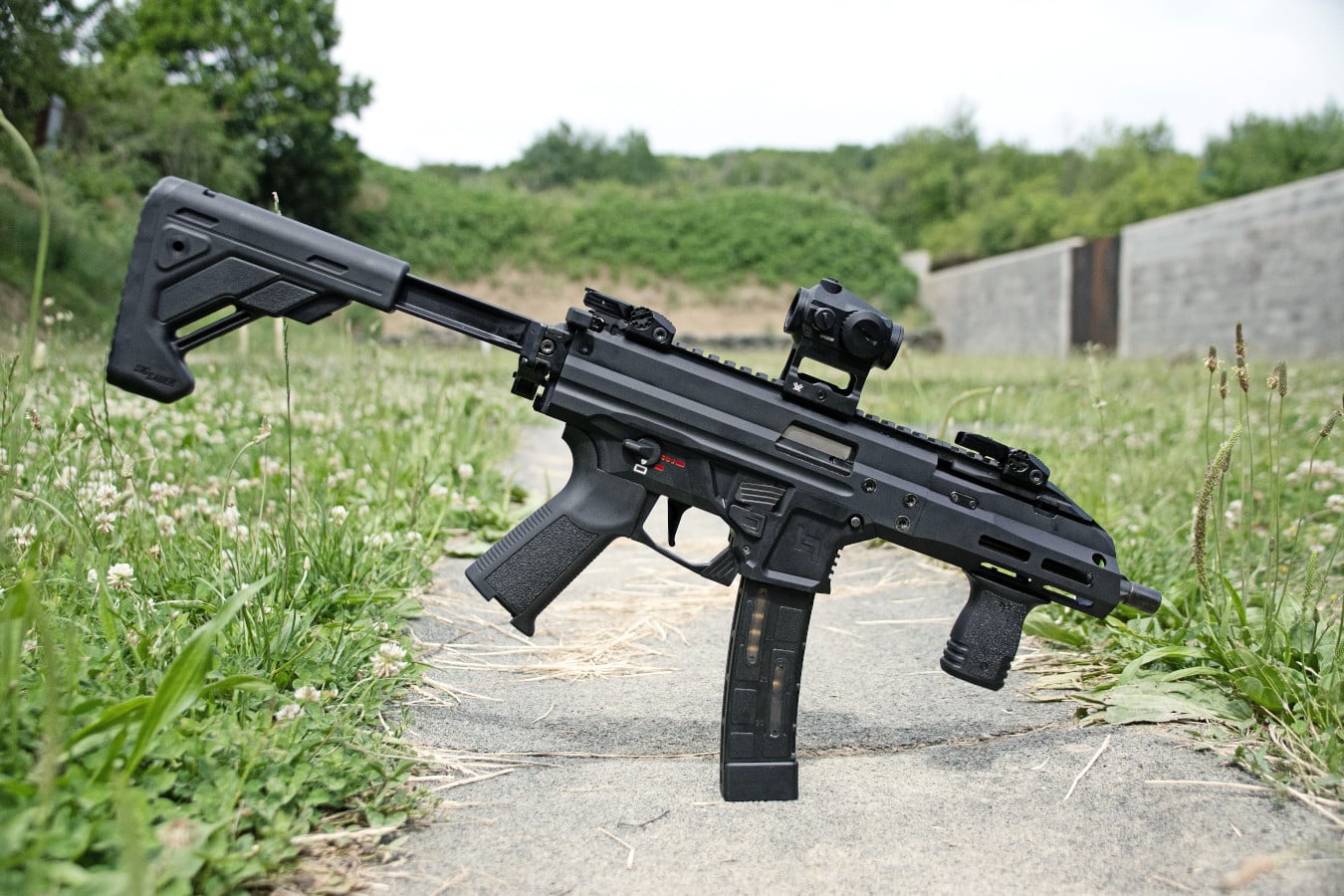One of the great things about the gun industry is the people you meet along the way. It’s part of belonging to a club that’ll always be regarded as outside of the mainstream, something not mentioned in polite company, yet its aficionados always seem to acknowledge each other in social settings. My older gay friends will no doubt relate.
Readers may not recognize the name of Jan Lucansky, but you’ll probably be familiar with his creations — he’s the designer behind two of the most iconic firearms of the 21st century, namely the CZ Scorpion subgun and the Laugo Arms Alien pistol. In addition to the Stinger 9, he’s currently working on a couple of other designs that will no doubt raise a few eyebrows.
Instead, the Scorpion arose from Lucansky’s experience in the Balkan Wars of the mid ’90s when he saw the need for an updated SMG that was light, compact, easy to manufacture, and less expensive than others on the market at the time.
Fun fact: Over a couple of glasses of local firewater during a previous visit to Czechia, we discovered that at one point Lucansky and your humble scribe served within mortar range of each other, though on different sides of the conflict.
The Scorpion’s success led to the development of perhaps the most innovative handgun of the past 30 years, and after selling Laugo Arms, Lucansky decided that although his previous design was good, there was still room for improvement. Enter the Stinger 9.
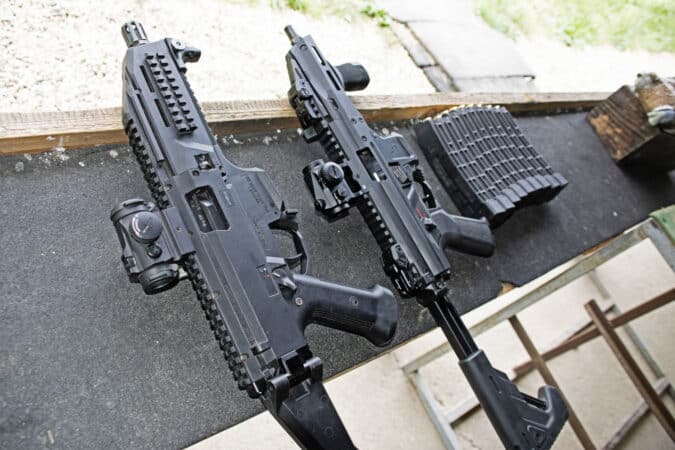
In creating the Stinger 9, it would appear that Lucansky and his team sat down with copies of every contemporary 9mm carbine and said, “How do we make this better?” Take, for example, the lower to upper receiver interface. It’s as tight as anything we’ve ever encountered due to a spring-loaded lever that applies pressure to the rear locking tab behind the pistol grip.
It doesn’t need it to function, and, truth be told, they could shave a few bucks from the price by deleting it, but boy, does it make for a solid, quality-feeling gun. The rest of the gun, likewise, shows an obsession with detail, something rare in a simple blowback 9mm.
LUCANSKY ARMS STINGER 9 SPECS
- Caliber: 9mm Para
- Capacity: 30 rounds
- Barrel length: 16, 8, 4, 3 inches
- Overall Length: Short
- Weight: Light
- MSRP: TBD
STEM TO STERN
The Stinger 9 is based on an extruded 6082-T6 aluminum upper receiver, mated to a polymer lower. There’s a steel front trunnion anchored by six Torx bolts that serve to mate the receiver and handguard, which can be readily swapped out at the user level to give options regarding length, suppressor use, etc.
The back of the receiver is capped with rear trunnion equipped with a Pic rail, so that a wide range of stocks can be added, should the end user wish, and there are similarities with SIG’s MPX, in that there are relief cuts in the sides of the receiver to accommodate the guide rails of a collapsing stock.
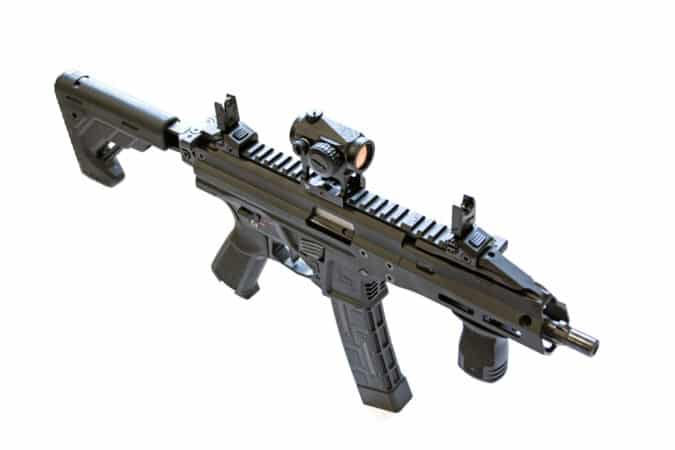
Like the Scorpion and others, the gun will be initially imported as a pistol so as to comply with 922(r) and the rest of the bullsh*t federal regulations, but with Form 2 processing times currently less than a month, we predict lots of these will be turned into SBRs.
The barrel is retained with an AR-style nut that threads to the trunion, and barrel options include 16-, 8-, 4-, and possibly a 3-inch version, though this necessitates deleting the forward charging handle. Suppressor use is supported through the presence of a tri-lug or threaded muzzle. Styling cues for the forend are taken from the Scorpion, with its tapered top section, though the Stinger 9 is more svelte and features M-Lok, rather than the 1913 rail attachment points found on the Evo 3.
The Stinger’s lower receiver hosts a combination of AR and HK controls. Any pistol grip you fancy can be swapped in, should you not like the one it ships with and the ambi selector switch falls right under the user’s thumb. The magazine release is likewise AR-ish, or at least the first one is.
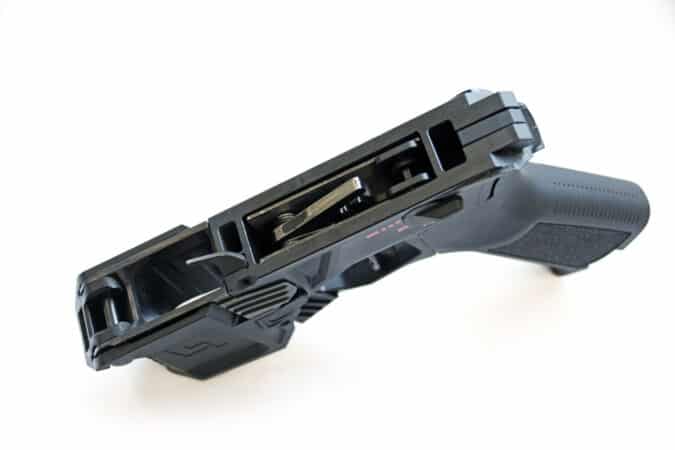
Consisting of an oversized button on both sides of the receiver, roughly where you’d expect it to be, it’s backed up by an HK/AK-style paddle behind the flared magwell, so you can either drop the magazine with your master index finger, strip it out as you would an MP5, or hit the AR mag release with the thumb of your support hand. No matter what other platforms you’re proficient with, there’s no excuse for fumbling a mag change on the Stinger 9.
As far as magazines go, any generation of Scorpion mags will work, as the Stinger latches on the original cutout at the rear of the mag body, unlike the Evo 3 that uses a window on the side. This prevents over insertion and subsequent stoppages.
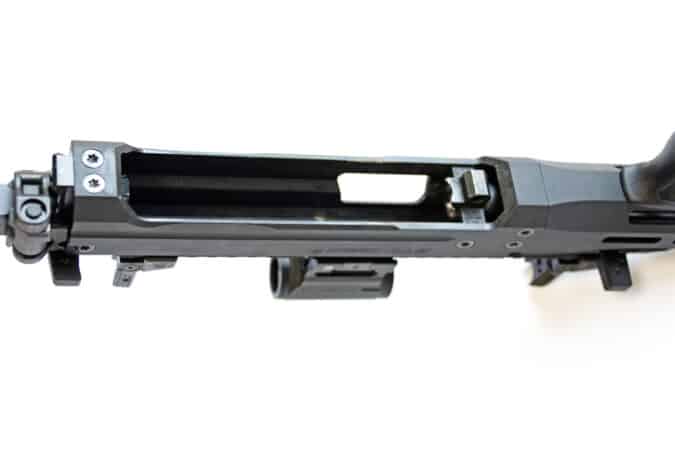
The Stinger’s charging handle(s) arrangement is likewise set up to facilitate an easy transition from other weapons. An AR-style handle latches into the receiver’s rear, but we don’t think this will get nearly as much use as its non-reciprocating counterpart. Yes, you can swap it from right to left side, and yes, you can do the HK slap for extra cool points. Or you can delete it entirely, if you can’t bear the thought of another rerun of Die Hard. The plastic handle is retained by a couple of roll pins, so aftermarket versions are easy to swap in.
Alternatively, the bolt can be locked to the rear and released using ambi hold open levers that can be activated by either the master hand index finger or support hand thumb. This all adds up to the perhaps the most comprehensive and accessible control package of any carbine or subgun out there.
To strip the Stinger 9, after observing normal safety protocols, simply press out the front, captured takedown pin and remove the lower receiver. Next, pull back the bolt assembly and remove it from the upper. Then, separate the recoil spring and guide rod from the bolt before pulling out the secondary guide rod that holds together the bolt and floating counterweight. Hang on, what? Insert sound of needle skipping across vinyl.
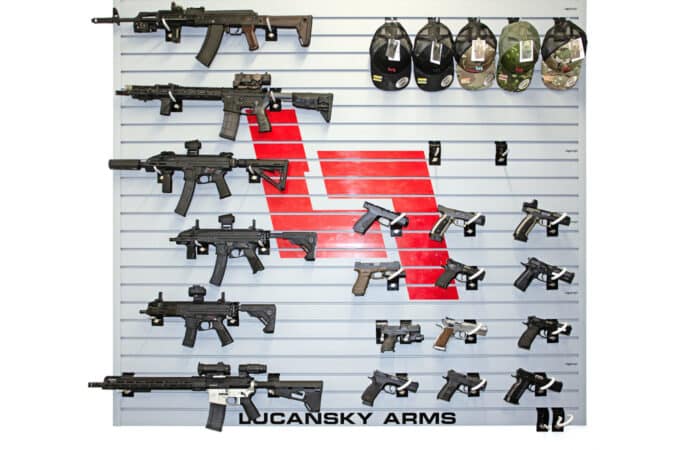
You see, the Stinger 9 incorporates a simple but effective means to reduce recoil that relies on a floating tungsten mass, incorporated into the bolt, which the designer has named Divided Matter. It works by essentially reducing the bolt’s weight at the time the shooter feels it — specifically at the end of its travel when the bolt slams into the rear of the receiver.
On firing, the mass is in its forward position, tight against the front of the bolt and riding in an oversized slot. During recoil, as the bolt hits the receiver and stops, the floating chunk of tungsten continues traveling rearward, and just as it’s about to hit the rear of its slot in the bolt, the bolt bounces forward, propelled by the recoil spring.
As the rearward-traveling tungsten mass hits the forward-traveling bolt, the two pause for a couple of milliseconds before charging forward to pick up and chamber the next round. This has the effect of decoupling the counterweight from the bolt, in effect reducing its mass when you most notice it and spreading out the recoil impulse over a longer timeframe.
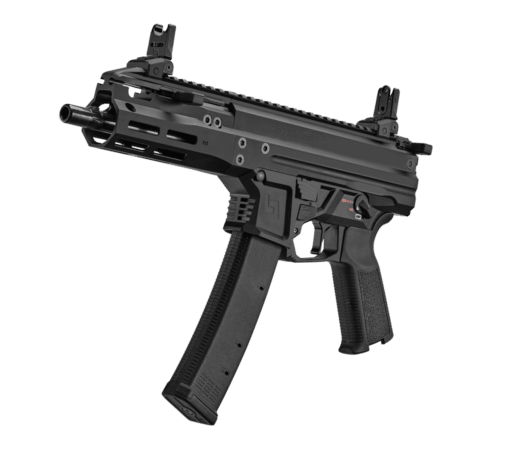
A side benefit is a reduction in cyclic rate, reducing the potential for stoppages caused by the magazine failing to keep up with the bolt. It’s elegant, simple, and effective.
ROUNDS DOWNRANGE
We had the opportunity to shoot the Stinger 9 side by side with a Scorpion Evo 3 and can say that the theoretical advantage offered by the Divided Matter system does indeed translate into a reduction in perceived recoil. It’s not as soft as, say, a full-sized MP5, but the Stinger 9 is also nowhere near as heavy as the HK with its steel receiver.
Although the guns we shot were prototypes, they ran without a hitch for the limited number of rounds we fed them, going through the best part of a case of 124-grain S&B ball in the course of a pleasant afternoon at the range in Uhersky Brod. If that name is familiar, it’s because another famous Czech firearms manufacturer shares the town, which is one of the reasons Lucansky chose to set up shop there — the subcontractor infrastructure is already in place.

Throughout our range session, we ran the 9mm carbine like an AR, then like an HK, and then using a combination of the two manuals of arms. The forward charging handle is very handy on a short gun like this and quickly became the preferred method of getting things up and running, but once the bolt locked back it became second nature to hit the mag release with the master index finger, then return the bolt into battery with the support hand thumb.
While we didn’t shoot for groups, preferring to get familiar with the controls and drive the gun across a steel target array, it’s a 9mm with a free floating barrel — there probably won’t be any surprises when it finally hits serial production. Speaking of which, the first batch of 2,000 should be hitting shelves across the western hemisphere right about the time you read this.
We may have to wait a few months to see them in the U.S. — as the ATF first has to give their blessing — but at a price point in the same ballpark as the Scorpion and Stribog, we expect them to sell quickly. No doubt there will be a lot of hype and hoopla surrounding its first U.S. public appearance at SHOT Show this coming January, but remember where you saw it first…
READ MORE SMG/PDW
Read the full article here




